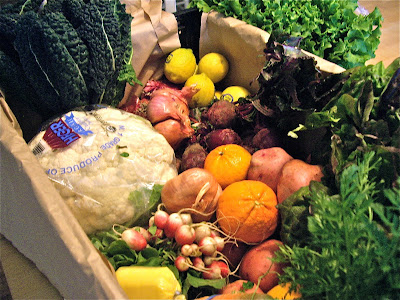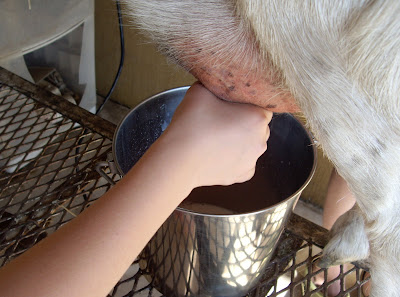Before I tell you where I would suggest you begin, you need to be aware of a few things that defeat people before they get started or before they are very far down the path...
• Family Resistance Never lie about what you are doing, but at the same time, you don't need to throw everyone into a panic that all their favorite comfort foods are going by the wayside. Be wise about it... and start with prayer! Your beginning can be as simple as mentioning that you've cooked something fun and new. If you think your spouse will be receptive, tell him that you want to start small and try one new thing each week. If you feel he will be resistant, begin with something that you know won't be a big issue for him. Don't ask him to give up his favorite food on the first step. This is why a Food Journey is different for every family! We all have certain likes and dislikes, and starting with something small and not too threatening is always more likely to be a success. I think family resistance is the number one issue Food Journeys fail, so we may need to talk more about this one on another post!
• Lack of Direction Have a plan; a simple outline of what you want to accomplish and where you are headed next. Don't put a lot of time constraints on yourself either. Just be watching closely to know when your family is ready for the next step. This is where I failed to pay attention. I was too satisfied with my single changes and probably didn't move fast enough! But, with the internet out there and so many of us reading about this kind of thing, the tendency is going to be to go too fast.
• Lack of Knowledge Hey, this is new territory. You're going to have to do some reading. You'll have to educate yourself. But I suspect that you will get past this one fairly easily or you wouldn't be here reading this and considering a Food Journey of your own! Just keep in mind that it doesn't stop with knowing you need to make a change. I have found that whenever I'm resistant to a new concept, I need to do some research to find out the "why" behind it. Once I've done that, I'm often ready to make a mental shift and move forward. It helps me to know why I'm doing what I'm doing and keeps me going when I wonder if it is really worth the lifestyle change.
• Lack of Skills Oh, now this one sounds scary! You mean this is going to require skills? What kind of skills? Skills we've lost along the way. Things as simple as how to cook from scratch to as complicated as milling and making our own bread. But let me put your mind at ease a bit. If you're taking one step at a time, then you're going to have time to learn one small skill at a time. But you do need to get your brain around the idea that you're going to have to do some learning. Personally, I loved this part of my Food Journey and I'm still fascinated with it. That's why I continue to study food, nutrition, and food preparation (remember that eCourse I told you I signed up for?). You can learn from blogs like this one, library books, even videos - some of which you can find on line for free (ain't YouTube great!).
• Lack of Support Again, I think I would have moved a bit faster on my path if I had found other bloggers to keep me going. Or even a good friend that was learning along with me. Since then, I have found several people that have the same mindset, but in the beginning, I felt like a pioneer off on the trail, all alone. Start talking about it with friends and see who's interested. Join a forum. Blog along with me and others. I'm hoping to generate some comments that will help us all!
• Lack of Resources Thankfully, this isn't as much of an issue as it was a few years ago. Capitalism is still working and those of us purchasing organics and such have sent our vote in by the all mighty dollar! And don't forget there are like minded farmers out there, too! (More on that on the next post). Talk to friends, stop at road side stands and ask if they know where you can get something you're looking for, ask your grocer, and search the web. You may need to order something on-line instead of purchasing locally. Thankfully, that is often an option. Some things like raw milk may be harder to find. But don't give up. It IS out there somewhere. And if it isn't available to you right now, it very well may be in the near future.
Okay, so keeping that in mind, where do I start? For each thing you eliminate, you need to replace it with something good. After all, your family has to eat, right?
Here is a list of general steps I would take if I were starting all over again:
1. Stop Consuming Processed Foods:
Eliminate: Food that comes in boxes, frozen foods that are not strictly a food item such as frozen peas (certainly not anything breaded to fry or bake), mixes for things like cakes, and items that can be purchased with a coupon (What??? Have you ever seen a coupon for an apple?).
Replacement: Shop the outer edges of the supermarket. Stick to the basic food groups - meat, fruits and vegetables, dairy products, and grains.
Learn: How to cook from scratch! Make real food in your kitchen and start a collection of recipes your family enjoys. Get rid of any that doesn't fit your new lifestyle or the family doesn't like (yes, purge the pantry by using up the bad and replacing it with the good). Recipezaar is a great on-line source for recipes from scratch as well as other bloggers. Tomorrow's post will have information to help you find a farmer's market or farm in your area. Also, you'll want to start reading food labels. This will make your grocery store trip take longer, but you'll begin to learn which foods are good for you and which foods are not.
2. Cut Out Refined Sugars and Artificial Sweeteners:
Eliminate: High Fructose Corn Syrup entirely, white table sugar (except for rare treats), and all man-made sweeteners including syrups made from these products.
Replacement: Honey, sucanat, pure maple syrup, molasses, and stevia. These should be used on a limited basis as they are still sugars.
Learn: How to use these new sweeteners in baking. Sue Gregg is one resource for this, but I just experimented on my own and found what worked for me. Perhaps well talk about this more later.
3. Switch to Whole Grains:
Eliminate: White bread, white rice, and any other refined grain that your family might eat. Avoid products that are "enriched" - something has been removed that shouldn't be and then they tried to add stuff back in. But they shouldn't have to do this if the product was healthy to begin with.
Replacement: Whole wheat breads (emphasis on the word "WHOLE", not just wheat bread - they aren't the same), brown rice, and even whole wheat bagels and such.
Learn: How to mill your own grains, bake your own bread, and make baked goods using a variety of whole grains. Research various grains and their common uses. Learn storage requirements. This is a bigger step than the first two, so that is why it isn't first. Hopefully, you'll be gaining momentum at this point and will be excited to jump in. Give yourself more time at this stage. There's a lot to learn here. I learned a lot from Sue Becker over at Bread Beckers, but also The Fresh Loaf and Baking 911 (for trouble shooting). Perhaps other bloggers would be willing to mention a source for this in the comment sections. I've written a few posts on grains and basic bread baking and hope to do more of this in the future. If your family is really adventurous and on board with you, then you might want to consider learning about soaking grains before consuming them. I know this sounds totally foreign, but some of you who have digestive issues, might want to take a serious look at this.
4. Switch to Raw Dairy Products:
Eliminate: Pasteurized, homogenized, non-organic products.
Replacement: Raw milk, yogurt, and kefir, as well as butter, cheeses, and other dairy products.
Learn: About the value of raw milk, a reliable source, and how to make dairy products from raw milk such as yogurt. This is going to be the hardest step for most people for several reasons, one of which is that we think raw milk is dangerous and only crazy people drink this stuff. To learn about raw milk, you really need to go to the Real Milk website and begin your education. Keep in mind that until the last 100 years or so, everyone drank raw milk. So how did everyone survive all those thousands of years without pasteurized milk? Because properly cared for animals produce good clean milk. It's what they were created to do. It's that simple.
5. Switch to Grass Fed, Pasture Raised, and Wild Caught Meats:
Eliminate: Conventionally raised meat products that confine animals most, if not all, of their lives and use corn as their main food source. You can be sure that their corn feed is genetically modified (GMO) as well. Avoid farm raised fish products.
Replacement: Beef that is grass fed, chicken that is free range and organic, and wild caught fish. I include "organic" because if they're feeding an animal corn, you must assume it is a GMO grain unless it specifically states the meat is organic.
Photo credit: juliebrown1
Learn: Not much to learn here other than knowing your source. You can still prepare your meats much the same way, but this step is last because it hits our pocket book so hard. You can expect prices to be about double what you're paying now. That's a lot of dough. Look for sales and stock up when you can! You can read more about this topic on my post Switching To Grass Fed Beef and finding a local source here. Once you realize what they are doing to our meats, you'll be more willing to pay up for the good stuff.
Wow. That's a lot of information. You may want to book mark this page or print it up for your cookbook binder. I hope it encourages you on your own Food Journey. And this isn't the end from Homestead Revival, rather just a beginning. I'll keep posting information that will help you along the way. Some posts that I wrote over at River Rock Cottage are already transferred over to help you out. And I'm working on moving more so keep checking back.
Where are you in your food journey and what do you want to learn this year in your next step?








